Tips From Sticks-In-The-Mud Woodshop
by Jim Randolph
Long Beach, Mississippi
Click on any picture to see a larger version.
Welcome to "Tips From Sticks-In-The-Mud Woodshop." I am a hobbyist, not a professional, someone who loves woodworking, just like you do. I have found some better ways to accomplish tasks in the workshop and look forward to sharing those with you each month, as well as hearing your problem-solving ideas.
Tip #1
Our forefathers in woodworking didn't have electronic conveniences, but they also didn't suffer with the shortcomings of technology. It is a truism that batteries are destined to discharge, then leak, and corrode everything they contact. You have two weapons to prevent such damage. One, you can create reminders in your computer and/or smart phone for each battery-operated device in your shop (including the backup batteries in your smoke detectors), replacing those batteries on a regular interval before they die and leak. Or, you can remove the batteries of seldom-used tools and pop them back in when in use.
When possible, I rubber-band the battery to the device, so it's completely handy. Some of the tools I use this technique on include: metal detector, which I use mostly when working with "found object" lumber, remote control for the air scrubber,
Stud Finder
, and the electronic blade height gauge.

|
|
If you like funky, old wood like I do,
you won't be in business long without one of these.
One 10-penny nail and there goes your
Forrest II Woodworker or planer blade.
|
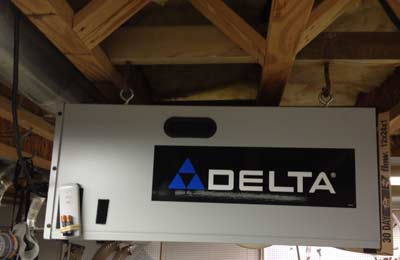
|
|
I'm tall, and the bottom of the rafters in my shop are only 8 feet,
so a remote control for the air cleaner doesn't get much use..
|

|
|
No more often than most of us use a stud finder, you are much more likely to have
to buy a new one because batteries leaked than because you wore it out!
Of course, that would set the perfect scenario to buy the new Franklin Pro Sensor!
|
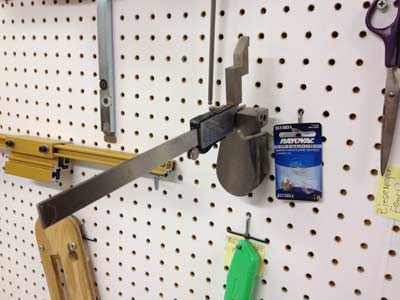
|
|
If I'm in a project and having to set blade height a lot,
I will leave the battery in this gauge until the project is finished,
then take it out when I'm between projects.
|
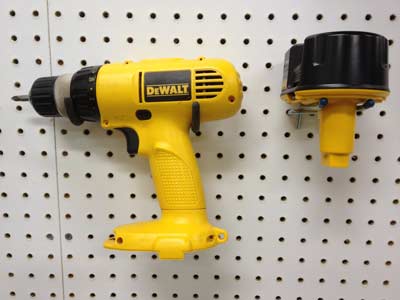
|
|
I'm not sure it actually makes a difference in how long a charge lasts,
but I take the battery out of the cordless drill-driver between uses, too.
|
At work we have only one tool (not counting flashlights) that uses batteries: our little Dremel tool for smoothing dogs' and cats' toenails. It simply doesn't get enough use to load it with rechargeable batteries.
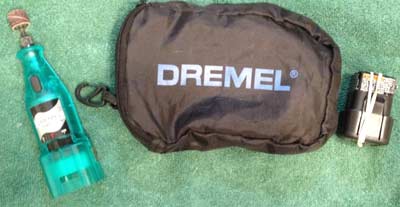
|
|
I expect this little Dremel to last us many years, and I certainly
don't want to lose it to something preventable, like battery leakage.
|
Tip #2
No Southern-fried Southern boy wants to be called a Yankee, but we share the characteristics of shrewdness and thrift. Thus, each month we include a money-saving tip. It's OK if you call me "cheap."
Rechargeable batteries can be great. The ones we use in our drills, saws, and other tools are technologically advanced and it would be difficult to put a value on the flexibility and mobility they give us. D, C, AA and AAA rechargeables have some shortcomings, but they still can be useful in the right applications, even if they don't measure up to the big rechargeables in our power tools. Rule Number One is that rechargeables make sense in items that are frequently used. If you aren't using a tool at least once daily, you are probably better off with a good, name-brand alkaline. At our house, we use AAs in my
Sinusense irrigator
.
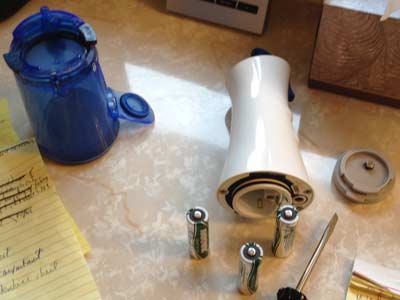
|
|
The unit uses 3 AAs, and they come in a pack of 4, so I rotate one out at each charging.
They are numbered 1-4 so I know which is which.
|
It gets used 1-4 times daily (depending on how dusty the work I'm doing is and whether I'm having nasal congestion). We also use them in my wife's portable fans. Brenda carries one everywhere she goes and has them stationed around the house. She won't be offended if you call her hot-blooded.
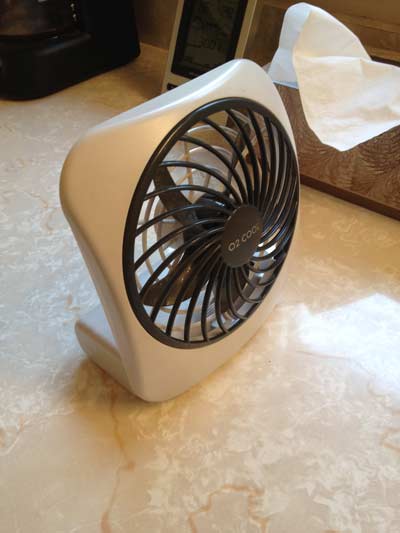
|
|
Brenda has sparked many conversations by whipping out one of these fans at a restaurant.
Waitresses "of a certain age" can really relate, especially if the waitress is having a hot flash at the same time she sees the fan.
Another advantage to rechargeable batteries is their relatively light weight.
|
Rule Number Two is, if you can't relinquish a little power, rechargeables aren't for you. When they first come off the charger they can amaze you with their power output. A few hours later, or after their first use, that power drops off noticeably, but stays at the new, slightly-lower level for a long time. In the case of the Sinusense the performance is completely acceptable. In the case of the spouse's fans, it takes a High setting to get the speed that an alkaline would give on Low. Because the fans are real power hogs, the tradeoff is worthwhile when you factor in the cost of alkaline batteries and the potential pollution of discarding their toxic innards.
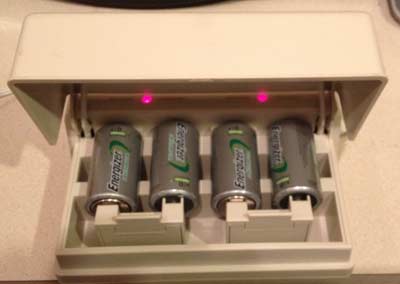
|
|
Charging time is short for most of these batteries.
|
As for chargers, I use a really old one. It's possible that the newer chargers have better electronics and might give better performance with the newest rechargeable batteries. If you don't have one at all, and you have some tools that justify rechargeable batteries, it is certainly a worthwhile investment. If you, like me, already have a charger, I don't think it makes sense to buy a new one.
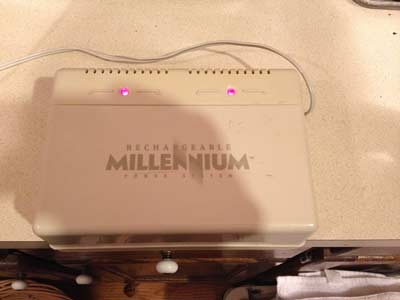
|
|
A newer charger might give us a faster charge,
but I am completely satisfied with this one, which is already paid for!
A real plus if you're cheap, like me!
|
Follow Up on last month's tip:
Last month
, we discussed using Water Pik's motorized Sinusense nasal irrigator to wash the wood dust and miscellaneous crud from our respiratory passages after sessions in the shop. Well, it turns out that the motorized model is no longer made by Water Pik.
DISCLAIMER: I haven't used any of the following alternative products:
NeilMed
makes a motorized unit that looks very much like the SinuSense unit, and is about the same price:
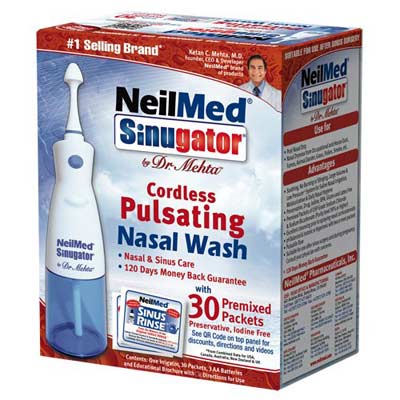
|
|
Even the shape of the NeilMed unit resembles the Water Pik SinuSense,
but the top is considerably different. If I were in the market for a replacement,
this is what I would try first.
|
Then, there is a mac daddy, the
SinuPulse Elite by Health Solutions
:
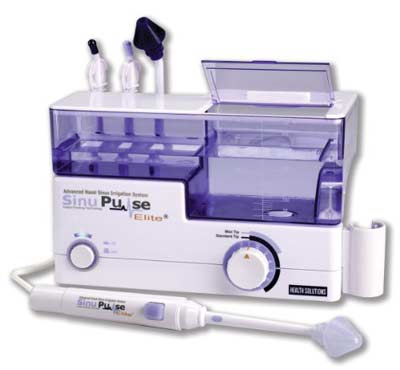
|
|
Reviews show 4 ½ stars for the SinuPulse, even though
it seems a little pricey and takes up a lot of real estate on your bathroom counter!
|
If my motorized SinuSense ever dies I know I will want to have something to irrigate with, so I will review one of them when I do. Or, maybe we'll get lucky and Water Pik will resume manufacture of their old unit.
Jim Randolph is a veterinarian in Long Beach, Mississippi. His earlier careers as lawn mower, dairy farmer, automobile mechanic, microwave communications electronics instructor and journeyman carpenter all influence his approach to woodworking. His favorite projects are furniture built for his wife, Brenda, and for their children and grandchildren. His and Brenda's home, nicknamed Sticks-In-The-Mud, is built on pilings (sticks) near the wetlands (mud) on a bayou off Jourdan River. His shop is in the lower level of their home. Questions and comments on woodworking may be sent to
DrRandolph@MyPetsDoctor.com
. Questions about pet care should be directed to his blog on pet care,
www.MyPetsDoctor.com
. We regret that, because of high volume, not all inquiries can be answered personally.
Return to
Wood News
front page


